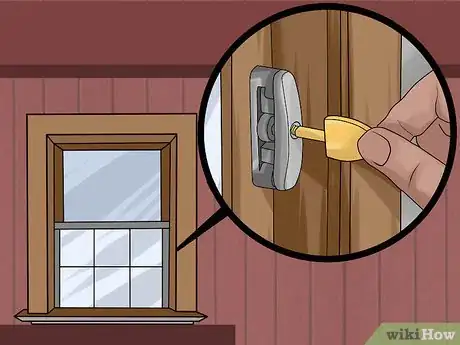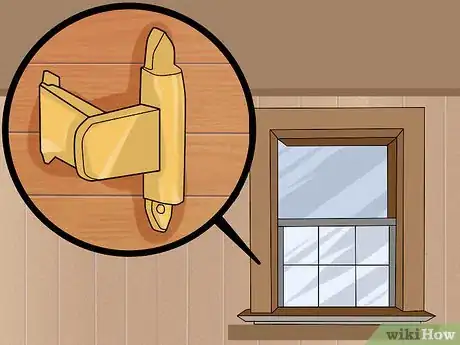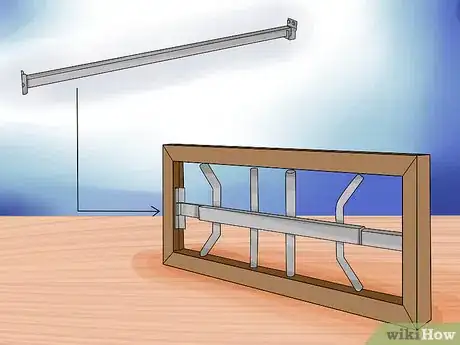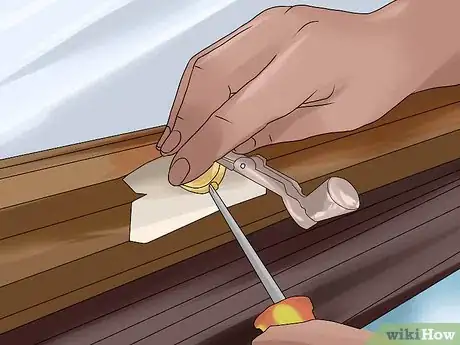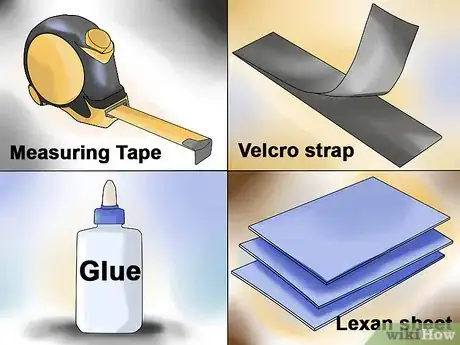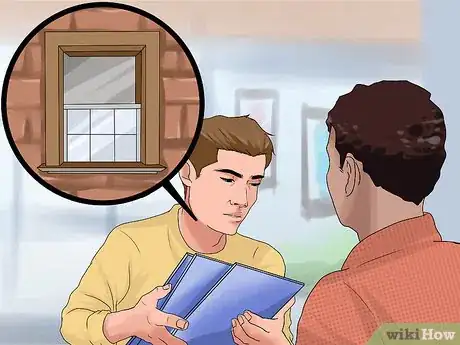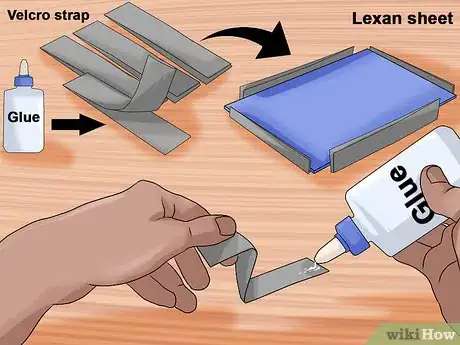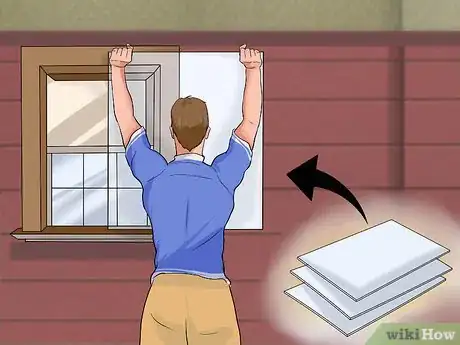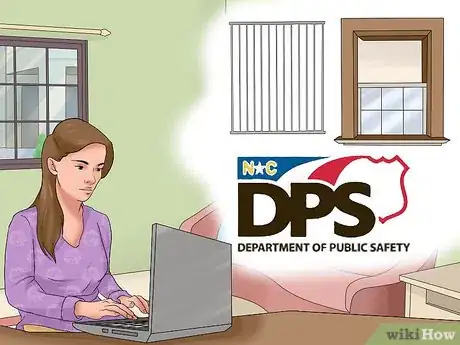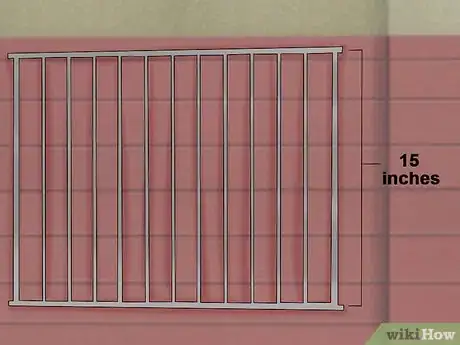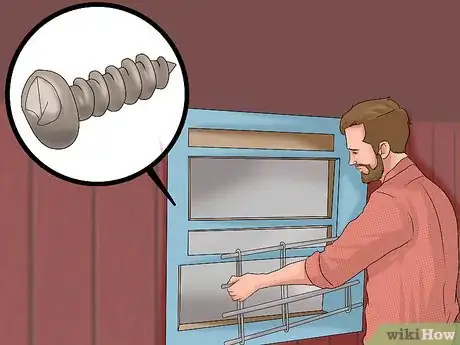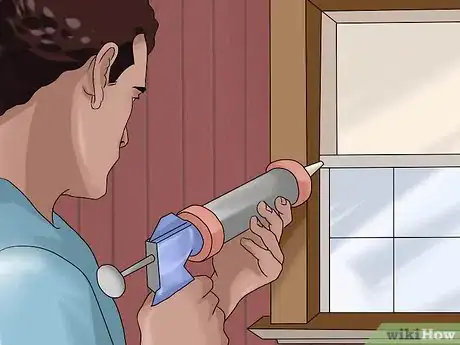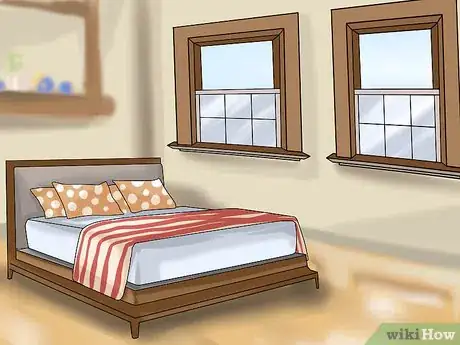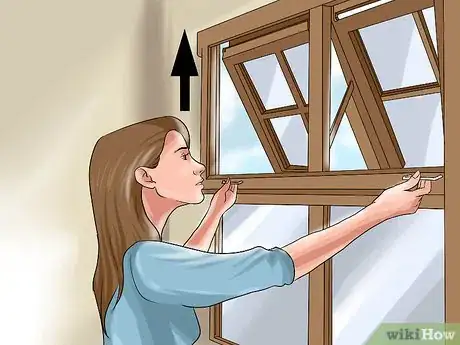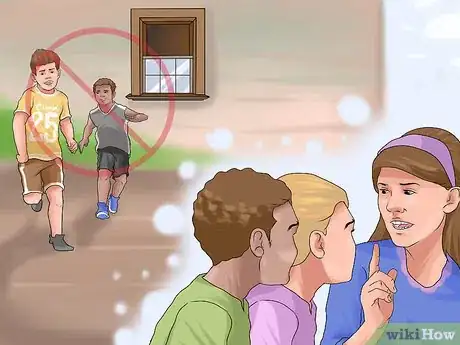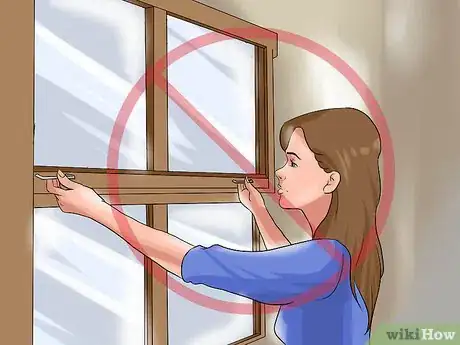This article was co-authored by Catherine Palomino, MS. Catherine Palomino is a former Childcare Center Director in New York. She received her MS in Elementary Education from CUNY Brooklyn College in 2010.
This article has been viewed 22,801 times.
Windows can prove hazardous for babies and young children. As babies start to crawl and walk, they can fall out of a window or cut themselves on the glass. Use several different forms of babyproofing so that if your baby gets past 1, they are still safe. You should keep your windows locked at all times. If you live in a high rise building, place a guard over your window. You should also practice basic safety by keeping climbable objects away from your windows. With a little diligence, you can easily baby-proof the windows in your apartment or home.
Steps
Keeping Windows Closed
-
1Lock your windows. Some windows have built-in locks you can latch shut with a key to prevent the window from opening. If your windows have keys built-in, this is your best option for baby proofing your windows. If your windows do not have keys, however, use another method. Installing keys is costly and time-consuming and it's far easier to use an alternative window locking method.
- You should have window locks somewhere in your home if your windows have built-in keys. They were likely given to you when you bought your home. If you're renting a building, ask your landlord for the keys to your window locks.[1]
- You can also replace the lock barrels in the event you cannot find window keys. You can find replacement barrels online or at a local hardware store. How to replace lock barrels varies in terms of the type of lock used in your window. Barrels should come with manufacturer's instructions explaining how to install them.[2]
- If you're unsure how to replace lock barrels yourself, hire a locksmith or handyman to do the work for you. You want to make sure the barrels are replaced correctly as it's important to lock your windows for the safety of your child.
-
2Try window stops. If you have windows that slide open, a window stop is a handy plastic device you can use to stop windows from opening. You can buy window stops at most hardware stores. You can also purchase them online.[3]
- Window stops are triangular shaped pieces of plastic that work by wedging the window shut. In the indent where the window slides up and down, you would wedge a window stop against the brim of the window. This should prevent the window from being opened.[4]
- You want to make sure you get the right size window stop. Measure the length of the indent on your wall. Make sure the window is not wider than that indent.
- You can have a window opened slightly with a window stop in place. If you choose to open your window, make sure the opening is no wider than four inches. A child should not be able to fit between a gap of this size or less.[5]
Advertisement -
3Use a charlie bar. A charlie bar is another device you can use to keep sliding windows closed. This is a metallic stick that fits between the top half of a wedged window and the portion of the window that slides up. If your window opens sideways, you can also fit a charlie bar into your window horizontally to keep it open. Keeping a charlie bar in place will prevent a child from opening a window.[6]
- Keep in mind, as your child grows older, he or she may be able to stand and reach the charlie bar. If your child is walking and getting taller, consider a method other than a charlie bar.
-
4Remove the handle of a cranked window. Crank windows are windows that can be opened by turning a small crank. Keeping cranked windows closed is very simple. You can simply remove the crank. For the most part, the crank can be removed by simply twisting it off. However, you may need a screwdriver to remove some screws in some crank windows.[7]
Baby Proofing an Unusual Window
-
1Gather your supplies. Some windows are designed in an unusual fashion and do not follow the crank or sliding opening pattern. Luckily, there is a method you can use that works for most windows. You'll need the following supplies, all of which can be purchased online or at a hardware store:
- Measuring tape
- Velcro strip
- Glue
- Lexan sheet[8]
- If you cannot find a lexan sheet, try another see-through plastic or light glass. Someone at the hardware store should be able to point you in the right direction.
- The advantage of a clear window guard is not limited to the fact it fits on most windows. A clear window guard also lets in light, preventing your home from feeling dark or dreary due to a window guard.
-
2Measure your windows. You will be attaching a lexan sheet inside your window using velcro. In order to determine how big of a sheet you'll need, measure your window vertically and horizontally. Write down these dimensions.[9]
-
3Have your lexan sheet cut in the right dimensions. Take your lexan sheet to a hardware store. Ask a worker to cut the sheet in the dimensions of your window. As a lexan sheet is made of plastic, it can be dangerous to attempt to cut it yourself unless you have experience working in hardware.[10]
-
4Use glue to attach the velcro. Attach four strips of velcro along each side of your lexan sheet. Then, attach four strips of velcro hooks along the side of your window. Use your glue to attach the velcro. As a child is not very strong, simple craft glue should be strong enough to keep your lexan sheet in place.[11]
- With very young children, velcro should be strong enough to hold the windows in place. Also, as the sheet is fit so tightly in the window, it would be difficult for a child to get a grip on the Lexan sheet to begin with.
- If your children are older, consider screwing the lexan sheet into the window frames. If you're renting, you should check with your landlord before drilling into the window.
-
5Put your lexan sheet in place. Once the glue has dried, place your lexan sheet into the window. It will now be hard for your child to slide or push open your window, as there is a guard in place. The advantage of lexan is that it also lets light through, avoiding your room becoming dark due to a window guard.[12]
- If you want to let airflow in through the window, consider drilling holes through the plastic with a power drill. Read the manufacturer's instructions on your lexan sheet first, however, to make sure you take proper safety precautions for the brand of lexan you're using.[13]
Obtaining a Window Guard
-
1Check your state's regulations. Window guards are metallic devices installed in the lower half of windows that slide open vertically. They are usually barred devices, designed to keep children from falling out of windows. Some states require window guards be installed under certain conditions.
- Window guards are usually required in public buildings. However, if you have a child under 10 living with you, a window guard may be mandatory by law. This varies by city and state. You can check your state's government website to find out your state's regulations. This is usually under the Department of Public Safety.
- A window guard is not easy to install. Some states may actually require professional installation. An improperly installed window guard can easily be removed by a child. The bars of a window guard are also prone to sloppy installation and can easily be installed in a way that would allow a child to fit through the guard.
- While professional installation may sound costly to you, it may actually not cost much at all. Your state may provide window guard installation for free or cheap. If you're renting a building, your landlord may be legally required to provide you with a window guard at no added cost. Once again, check with your state's Department of Public Safety.
-
2Choose the correct type of window guard. Window guards come in many shapes and sizes. However, you should make sure you choose a window guard that's safe for your type of window.
- A safe window guard should be at least 15 inches tall. The bars in the window guard should be close enough together that a 5-inch ball cannot pass through. A window bar that does not meet these regulations is not considered safe. It also may not legally count as a window guard by your state, which could land you in legal trouble depending on your state's regulations.
- Some states, such as New York, have a list of approved window guard manufacturers. You should check to see if your state has such a list before selecting a window guard.
- When purchasing a window guard, you should make sure the guard is safe for your specific type of windows. Somewhere on the ordering form or box containing the guard, it should specify what type of window this guard is compatible with. You can purchase a window guard online or at a local hardware store.
-
3Obtain one-way screws. In order to be safe, window guards should not come off easily. One-way screws, installed with a Philips head screwdriver, are vital for the safe installation of window guards. Before having your guard installed, pick up a handful of one-way screws at a local hardware store.
-
4Have a professional install the window guard. It is not recommended that you install a window guard yourself. Window guards are complicated to install. A faulty window guard is extremely dangerous as a child could slip and fall out of a window. Many states require professional installation.
- Call a local hardware store and ask if they do installation. If they do not, they may be able to direct you to a local business that installs household items like window guards. Always read reviews of any establishment you're doing business with ahead of time. Make sure customers were satisfied. Good service is especially vital when the safety of your children is at stake.
- Be sure to keep your receipt and the proof of installation, just in case something goes wrong. Keep it in a safe place where you will not lose it.
- If you live in an apartment, your landlord may be legally required to provide a window guard, free of charge, if you live with a child under 10. Call your landlord and request a window guard be installed as soon as possible.
Following Basic Window Safety
-
1Clear the areas around windows. You should keep the areas around the window clear. If you have objects like dressers, cribs, or beds near the windows, a child could climb on these objects and get out the window.[14]
-
2Open windows from the top. Some sliding windows can be opened from either the top or the bottom. If you're able to open a window from the top, do so. It will be much harder for a baby to access the top of the window than the bottom. Just to be safe, however, keep the opening less than four inches.[15]
-
3Instruct children not to play near windows. Teach your children to take proper precaution involving windows. While many safety devices can reduce the chance of accidents, there is always a slight risk such devices will fail. Therefore, it's important that you keep your child away from the windows.
- Raise your voice gently to explain to deter your child when he or she is playing near the window. Always explain why the window is dangerous. Do not just say, "I don't want you playing near the window." Say, "I don't want you playing near the window because you could fall and get hurt."[16]
- Be consistent. Keep an eye on your child at all times. Always correct the child when he or she is playing near the window.[17]
-
4Do not rely on bug screens. Many people feel bug screens can safely protect a child from falling from a window. Bug screens are not window guards and should not be treated as such. Screens are flimsy and a child could easily break through a bug screen and fall.[18]
Warnings
- No amount of babyproofing will substitute for watching your baby carefully. Babies can get themselves into dangerous situations very quickly, and it is important that they are supervised.⧼thumbs_response⧽
- In the event you cannot find a professional to install a window guard, check with your state's Department of Public Safety before attempting to install one yourself. It may not be legal for an average citizen to install a window guard on their own, depending on the state's regulations.⧼thumbs_response⧽
References
- ↑ http://parent.guide/how-to-baby-proof-windows/
- ↑ http://parent.guide/how-to-baby-proof-windows/
- ↑ http://parent.guide/how-to-baby-proof-windows/
- ↑ http://parent.guide/how-to-baby-proof-windows/
- ↑ http://parent.guide/how-to-baby-proof-windows/
- ↑ http://parent.guide/how-to-baby-proof-windows/
- ↑ http://parent.guide/how-to-baby-proof-windows/
- ↑ http://parent.guide/how-to-baby-proof-windows/
- ↑ http://parent.guide/how-to-baby-proof-windows/
- ↑ http://parent.guide/how-to-baby-proof-windows/
- ↑ http://parent.guide/how-to-baby-proof-windows/
- ↑ http://parent.guide/how-to-baby-proof-windows/
- ↑ http://parent.guide/how-to-baby-proof-windows/
- ↑ http://onsafety.cpsc.gov/blog/2010/04/09/how-to-child-proof-your-windows/
- ↑ http://onsafety.cpsc.gov/blog/2010/04/09/how-to-child-proof-your-windows/
- ↑ http://parent.guide/how-to-baby-proof-windows/
- ↑ http://parent.guide/how-to-baby-proof-windows/
- ↑ http://onsafety.cpsc.gov/blog/2010/04/09/how-to-child-proof-your-windows/
